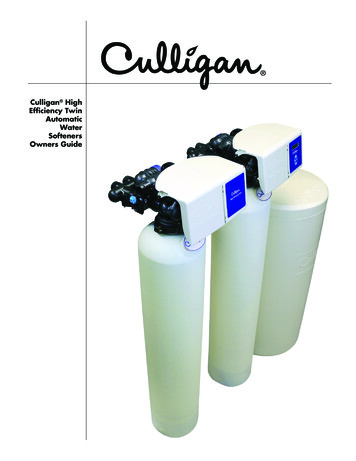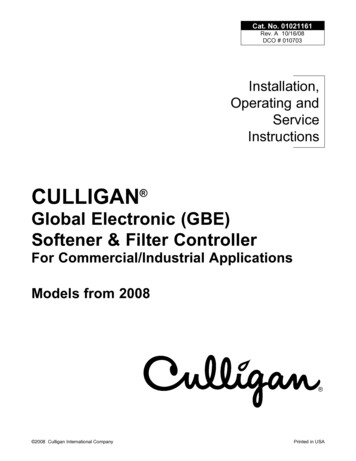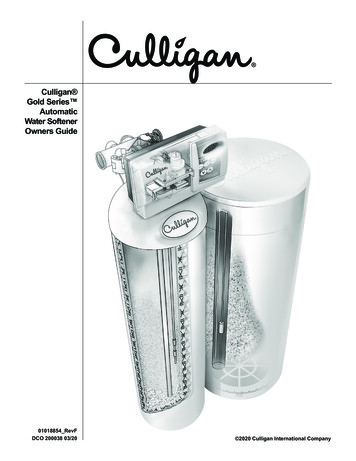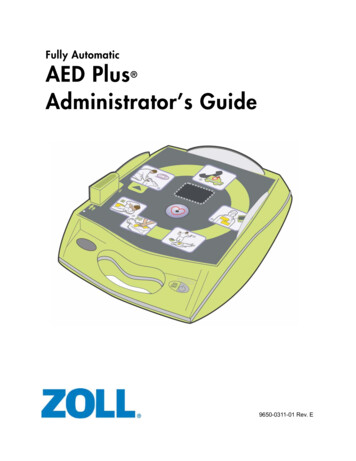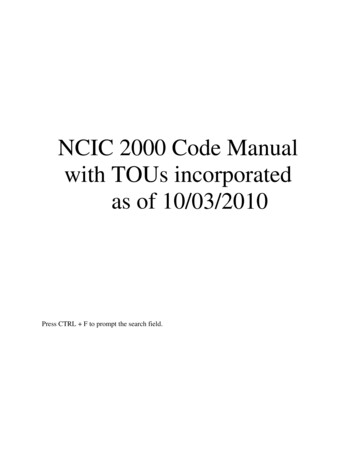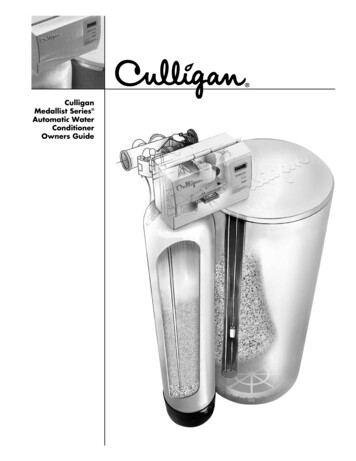
Transcription
CulliganMedallist Series Automatic WaterConditionerOwners Guide
Thank YouAnd Welcome To Your New World Of Better Living WithCulligan Water.The Culligan Medallist Series 8 Water Softeners are tested and certified byWQA against NSF/ANSI Standard 44 for the effective reduction of hardness(calcium and magnisium) and barium/radium as verified and substantiated bytest data.The Culligan Medallist Plus Series 30, 45 and 60 Water Softeners are testedand certified by WQA against NSF/ANSI Standard 44 for the effectivereduction of hardness (calcium and magnesium) and barium/radium as verifiedand substantiated by test data.The Culligan Medallist Plus Series 30, 45 and 60 Water Softeners are tested and certified by WQAagainst NSF/ANSI Standard 61 for material requirements.For installations in Massachusetts, Massachusetts Plumbing Code 248 CMR shall beadhered to. Consult your licensed plumber for installation of this system. This systemand its installation must comply with state and local regulations. The use of saddlevalves are not permitted.Hardness sample kits are available through your local Culligan Dealer.If this is your first experience having soft, conditioned water in your home, you’ll be amazed at themarvelous difference it makes. We promise that you’ll never want to be without it again.Congratulations, too, on selecting one of the “first family” of water conditioners in the prestigiousCulligan Medallist Series. With Culligan’s many years of knowledge and experience in watertreatment, you can be confident that the model you selected has been designed and engineered toprovide years of service with a minimum of care and attention.Some localities have corrosive water. A water softener cannot correct this problem and so its printedwarranty disclaims liability for corrosion of plumbing lines, fixtures or appliances. If you suspectcorrosion, your Culligan Dealer has equipment to control the problem.SODIUM INFORMATION: Water softeners using sodium chloride for regeneration add sodium to thewater. Persons who are on sodium restricted diets should consider the added sodium as part of theiroverall sodium intake.Attention Culligan Customer:The installation, service and maintenance of this equipment should be rendered by a qualified andtrained service tech ni cian. Your lo cal in de pen dent ly operated Culligan dealer employs trainedservice and maintenance personnel who are experienced in the in stal la tion, func tion and re pair ofCulligan equipment. This pub li ca tion is written spe cif i cal ly for these in di vid u als and is in tend ed fortheir use.iiWe encourage Culligan users to learn about Culligan prod ucts, but we believe that productknowledge is best ob tained by con sult ing with your Culligan dealer. Untrained in di vid u als who usethis man u al assume the risk of any resulting property damage or personal injury.
Performance Data Sheets are included in this manual for various Culligan Medallist Series Softenermodels. Refer to the Performance Data Sheet for your specific softener, as there are slight differencesbe tween the models. The softener warranty is located on page 49 of this Owner’s Guide.Table ofContentsSpecifications . . . . . . . . . . . . . . . . . . . . . . . . . . . . . . . . . . . . . . . . . . . . . . . . . . . . . . . 1Introduction . . . . . . . . . . . . . . . . . . . . . . . . . . . . . . . . . . . . . . . . . . . . . . . . . . . . . . . . 2Preparation . . . . . . . . . . . . . . . . . . . . . . . . . . . . . . . . . . . . . . . . . . . . . . . . . . . . . . . . 7Installation . . . . . . . . . . . . . . . . . . . . . . . . . . . . . . . . . . . . . . . . . . . . . . . . . . . . . . . . . 9Programming . . . . . . . . . . . . . . . . . . . . . . . . . . . . . . . . . . . . . . . . . . . . . . . . . . . . . . 17Final Start-Up . . . . . . . . . . . . . . . . . . . . . . . . . . . . . . . . . . . . . . . . . . . . . . . . . . . . . . 21Salt, Supply, Usage and Service . . . . . . . . . . . . . . . . . . . . . . . . . . . . . . . . . . . . . . . . . 23Care and Cleaning of your Water Conditioner . . . . . . . . . . . . . . . . . . . . . . . . . . . . . . 24Recommended Preventative Maintenance . . . . . . . . . . . . . . . . . . . . . . . . . . . . . . . . . . 24Sanitizing Procedure . . . . . . . . . . . . . . . . . . . . . . . . . . . . . . . . . . . . . . . . . . . . . . . . . 26To Clean Out the Salt Storage Tank . . . . . . . . . . . . . . . . . . . . . . . . . . . . . . . . . . . . . . 27Error Codes . . . . . . . . . . . . . . . . . . . . . . . . . . . . . . . . . . . . . . . . . . . . . . . . . . . . . . . 27Things to Check Before You Call for Service . . . . . . . . . . . . . . . . . . . . . . . . . . . . . . . . . 28When and How to Bypass your Water Conditioner . . . . . . . . . . . . . . . . . . . . . . . . . . . 29Culligan Medallist Series 8” Water Softener PDS . . . . . . . . . . . . . . . . . . . . . . . . . . . . 30Culligan Medallist Series 8” Water Softener with Soft-Minder Meter PDS . . . . . . . . . . . 31Culligan Medallist Plus Series 30 Water Softener PDS . . . . . . . . . . . . . . . . . . . . . . . . . 32Culligan Medallist Plus Series 30 Water Softener with Soft-Minder Meter PDS . . . . . . . 33Culligan Medallist Plus Series 45 Water Softener PDS . . . . . . . . . . . . . . . . . . . . . . . . . 34Culligan Medallist Plus Series 45 Water Softener with Soft-Minder Meter PDS . . . . . . . 35Culligan Medallist Plus Series 60 Water Softener PDS . . . . . . . . . . . . . . . . . . . . . . . . . 36Culligan Medallist Plus Series 60 Water Softener with Soft-Minder Meter PDS . . . . . . . 37California Certificates . . . . . . . . . . . . . . . . . . . . . . . . . . . . . . . . . . . . . . . . . . . . . . . . 38Parts List . . . . . . . . . . . . . . . . . . . . . . . . . . . . . . . . . . . . . . . . . . . . . . . . . . . . . . . . . 42Records and Data . . . . . . . . . . . . . . . . . . . . . . . . . . . . . . . . . . . . . . . . . . . . . . . . . . . 53Warranty . . . . . . . . . . . . . . . . . . . . . . . . . . . . . . . . . . . . . . . . . . . . . . . . . . . . . . . . 54iii
SpecificationsCulligan Medallist Series Water Conditionerswith Timeclock or Soft-Minder MeterMedallist8” Model30 Model45 Model60 Model3/4” 5-cycleReinforcedThermoplastic1” 5-cycle ReinforcedThermoplastic1” 5-cycle ReinforcedThermoplastic1” 5-cycle ReinforcedThermoplastic51 in., 1,295 mm49 in., 1,245 mm63 in., 1,600 mm61 in., 1549 mm8 x 44 in.203 x 1,118 mm10 x 40 in.254 x 1,016 mm10 x 54 in.254 x 1,372 mm12 x 52 in.305 x 1,321 mm18 x 43 in.457 x 1,092 mm18 x 43 in.457 x 1,092 mm18 x 43 in.457 x 1,092 mm18 x 43 in.457 x 1,092 mmCullex Media, 0.7 ft3Cullex Media, 1.0 ft3Cullex Media, 1.5 ft3Cullex Media, 2.0 ft3Cullsan Underbedding, 6 lb.CullsanUnderbedding,15 lb.CullsanUnderbedding,15 lb.CullsanUnderbedding,16 lb.17,004 gr @ 4 lb.17,172 gr @ 4 lb.26,700 gr @ 6 lb.35,614 gr @ 8 lb.22,947 gr @ 9 lb.23,664 gr @ 8 lb.38,830 gr @ 12 lb.51,659 gr @ 16 lb.24,853 gr @ 12 lb.27,700 gr @ 12 lb.45,493 gr @ 18 lb.60,523 gr @ 24 lb.4251 gr./lb. @4.0 lb. salt dosage4293 gr./lb. @4.0 lb. salt dosage4461 gr./lb. @6.0 lb. salt dosage4451 gr./lb.@8.0 lb. salt dosage20.5 - 21.5 in.13 in.15 in.16 in.42.0 - 42.5 in.35 in.48 in.46 in.Salt Storage Capacity250 lb. or 375 lb.250 lb. or 375 lb.375 lb.375 lb.Rated Service Flow @ Press. Drop5.9 gpm @ 12 psi10 gpm @ 15 psi9.4 gpm @ 15 psi10.2 gpm @ 15 psiTotal Hardness, Maximum75 gpg75 gpg99 gpg99 gpgTotal Iron, Max. (dissolved)5 ppm5 ppm5 ppm5 ppmControl Valve TypeOverall Conditioner HeightMedia Tank Dimensions(Dia. x Ht.)Salt Storage Tank Dimensions(Dia. x Ht.)Exchange Media, Type & QtyUnderbedding, Type &QuantityExchange Capacity @ SaltDosage Per Recharge1Efficiency at Rated SaltDosage5Freeboard to Media2Freeboard toUnderbedding3Hardness to Iron Ratio,Minimum8 gpg to 1 ppm8 gpg to 1 ppm8 gpg to 1 ppm8 gpg to 1 ppm140 mg/L to 1 mg/L140 mg/L to 1 mg/L140 mg/L to 1 mg/L140 mg/L to 1 mg/LOperating Pressure20 - 125 psi /140 - 860 kPa20 - 125 psi /140 - 860 kPa20 - 125 psi /140 - 860 kPa20 - 125 psi /140 - 860 kPaOperating Pressure (Canada)20 - 90 psi /140 - 620 kPa20 - 90 psi /140 - 620 kPa20 - 90 psi /140 - 620 kPa20 - 90 psi /140 - 620 kPa33 - 120 F ,1 - 50 C33 - 120 F ,1 - 50 C33 - 120 F ,1 - 50 C33 - 120 F ,1 - 50 COperating TemperatureElectrical RequirementsElectrical Power Consumption,Min./Max.Drain Flow, Maximum4Recharge Time, AverageRecharge Water Consumption123 45Medallist Plus24V/60 Hz24V/60 Hz24V/60 Hz24V/60 Hz3 Watts/35 Watts3 Watts/35 Watts3 Watts/35 Watts3 Watts/35 Watts1.1 gpm1.7 gpm1.6 gpm2.6 gpm85 min.64 min.64 min.52 min.23.3 gal.36 gal.46 gal.51 gal.Capacities and corresponding salt dosages pertain to low hardness waters. Capacities given per recharge.Measured from top of media to top of inlet fitting (backwashed and drained) for 8” tanks. Measured from topof media to top surface of tank threads for 10” and 12” tanks.Measured from top of underbedding to top of inlet fitting for 8” tanks. Measured from top of media to topsurface of tank threads for 10” and 12” tanks.Backwash at 120 psi (830 kPa)Efficiency rating only valid at stated salt dosage on softminder models and is efficiency rated according toNSF/ANSI Standard 44.
Read this Manual FirstBefore you operate the Medallist Series Water Softening System, read this manual to become familiarwith the device and its capabilities.IntroductionWatch for Special ParagraphsPlease read the special paragraphs in this manual. Examples are shown below.Safe PracticesThroughout this manual there are paragraphs set off by special headings.Note: Check and comply with your state and local codes. You must follow these guidelines.For installations in Massachusetts, Massachusetts Plumbing Code 248 CMR shallbe adhered to. Consult your licensed plumber for installation of this system. Thissystem and its installation must comply with state and local regulations. The useof saddle valves are not permitted.Note: Note is used to emphasize installation, operation or maintenance information which isimportant, but does not present any hazard. Example:Note: The nipple must extend no more than 1 inch above the cover plate.Caution: Caution is used when failure to follow directions could result in damage to equipment orproperty. Example:Caution! Disassembly while under water pressure can result in flooding.Warning: Warning is used to indicate a hazard which could cause injury or death if ignored. Example:Warning! Electrical shock hazard! Unplug the unit before removing thecover or accessing any internal control parts.Serial NumbersThe control valve serial number is located on the back of the timer case.The media tank serial number is located on the top surface of the tank.Note: Do not remove or destroy the serial number. It must be referenced on request forwarranty repair or replacement.This publication is based on information available when approved for printing. Continuing designrefinement could cause changes that may not be included in this publication.Products manufactured and marked by Culligan International Company (Culligan) and its affiliatesare protected by patents issued or pending in the United States and other countries. Culligan reservesthe right to change the specifications referred to in this literature at any time, without prior notice.Culligan, Aqua-Sensor, Tripl-Hull, Flo-Pak and Soft-Minder are trademarks of Culligan InternationalCompany or its affiliates.
Introduction(cont.)It’s All So Easy, So Economical, So Efficient, So Enjoyable!Kind To Skin And ComplexionSoft water will help prevent red, itchy or dry skin because there are no hardness impurities to causesoreness, no soap curd to coat the skin. Shaving is easier, smoother - either with blade or electricshaver.Bathing And ShoweringYou’ll use far less soap with conditioned water. Use your soap very spar ing ly - not as you did beforesoft water. Just a quick rinse removes all lather, leaving your skin pleasantly smooth and silky - becausenow it’s free of sticky soap curd and film.Saves Washing Costs. Helps Control Environmental PollutionSoft water washes whiter and cleaner with less soap or detergent. Be cause the hardness im pu ri ties arere moved, your soap can concentrate solely on washing. People usually find that they can reduce theamount of soap they use sub stan tial ly. If you normally used a cup per wash load with hard water, tryusing only 1/3 cup depending on the size of your wash load and the degree of soil. Different amountsare required, but you can use less with softened water. An added bonus is the fact that your washablefabrics will last longer.Super Hair ConditioningSoft water is great for scalp and hair care. No insoluble deposits are formed. Hair is shinier, softer,more manage able. Reduce the amount of shampoo you have normally used.Dishes Are A DelightWashed by hand or in a dishwasher, glassware, dishes and silver wash cleaner, easier. Follow yourdish wash er manufacturer’s instructions. Soft water promotes sanitation because no greasy hard waterfilm can form to collect or harbor bacteria.Easier Housekeeping, Gleaming FixturesYou’ll be amazed at the marvelous difference. Just a swish of the cloth, and the bathtub or shower andfixtures are clean and sparkling. Imagine, no scouring! No hard water scum to cause rings, streaks,spots and stains. To keep their gleaming luster, simply wipe fixtures with a towel after use. Formica,tile, walls, floors, woodwork surfaces clean easier, stay clean long er. You’ll save on cleaning aids andsave on time.
Saves Water-Heating Energy, Helps Water-Using AppliancesSoft water reduces the formation of rock-like hard water scale which encrusts water heaters, hot waterpipes, shower heads, and water-using appliances. This scale can cause premature maintenance andfailure.Introduction(cont.)Elimination of hard water also provides substantial energy savings be cause scale acts as an insulator,wasting electricity or gas used to heat water.Savings GaloreA water conditioner is frequently referred to as “the appliance that pays for itself”. You’ll find thatyour savings on soaps, detergents, cleaning aids, and personal care products will help your fam i ly’shousehold budget. And if you place a price on your time, you’ll be most happy with the time saved byyour new family servant.Water For Lawns And Household PlantsIf possible, lawn sprinkling faucets should be supplied with hard water primarily because it isuneconomical to soften so much water.Household plants are much more sensitive than lawns with respect to the kind of water which is best.First, because they receive no rainfall and, second, there is little or no drainage of the soil. Preferablythey should be watered with rainwater or water which is low in mineral con tent such as distilled ordemineralized water. Softened water is not recommended for house plants because a build-up ofsodium in the soil may interfere with efficient absorption of water by the plant root system. Additionalinformation may be obtained from your independently op er at ed Culligan dealer.Why Water Gets Hard And How It’s SoftenedAll of the fresh water in the world originally falls as rain, snow, or sleet. Surface water is drawnupward by the sun, forming clouds. Then, nearly pure and soft as it starts to fall, it begins to collectimpurities as it passes through smog and dust-laden atmosphere. And as it seeps through soil androcks it gathers hardness, rust, acid, unpleasant tastes and odors.Water hardness is caused primarily by limestone dissolved from the earth by rainwater. Because ofthis, in earlier times people who wanted soft water col lect ed rainwater from roofs in rain barrels andcisterns before it picked up hardness from the earth.Some localities have corrosive water. A softener cannot correct this prob lem and so its printedwarranty disclaims liability for corrosion of plumb ing lines, fix tures or appliances. If you suspectcorrosion, your Culligan Man has equipment to control the problem.
Introduction(cont.)Iron is a common water problem. The chemical/physical nature of iron found in natural water suppliesis exhibited in four general types:1. Dissolved Iron - Also called ferrous or “clear water” iron. This type of iron can be removedfrom the water by the same ion exchange principle that removes the hardness elements, calciumand magnesium. Dissolved iron is soluble in water and is detected by taking a sample of thewater to be treated in a clear glass. The water in the glass is initially clear, but on standingexposed to the air, it may gradually turn cloudy or colored as it oxidizes.2. Particulate Iron - Also called ferric or colloidal iron. This type of iron is an undissolved particleof iron. A softener will remove larger particles, but they may not be washed out in re gen er a tioneffectively and will eventually foul the ion exchange resin. A filtering treatment will be required toremove this type of iron.3. Organic Bound Iron - This type of iron is strongly attached to an organic compound in thewater. The ion exchange process alone cannot break this at tach ment and the softener will notremove this type of iron.4. Bacterial Iron - This type of iron is protected inside a bacteria cell. Like the organic bound iron,it is not removed by a water softener.When using a softener to remove both hardness and dissolved iron it is im por tant that it regeneratesmore frequently than ordinarily would be calculated for hardness removal alone. Although manyfactors and formulas have been used to determine this frequency, it is recommended that the softenerbe re gen er at ed when it has reached 50 - 75% of the calculated hardness alone capacity. This willminimize the potential for bed fouling. (Iron removal claims have not been verified by the WaterQuality Association or Underwriters Laboratories.)If you are operating a water softener on clear water iron, regular resin bed cleaning is needed to keepthe bed from coating with iron. Even when operating a softener on water with less than the maximumof dissolved iron, regular cleanings should be performed. Clean every six months or more often if ironappears in your conditioned water supply. Use resin bed cleaning compounds carefully following thedirections on the container.Caution! Do not use where the water is microbiologically unsafe or with water ofunknown quality without adequate disinfection before or after the unit.
The Culligan ProcessYour Culligan water conditioner consists of three basic components, (A) the Control Valve, (B) theMineral Tank, and (C) the Brine System.Introduction(cont.)A. The exclusive Culligan control valve automatically performs a variety of tasks that are necessaryfor the proper operation of your water conditioner. These tasks, com mon ly referred to as cycles oroperating positions, are Service, Regeneration, and Brine Refill.1. Service: While the control valve is in the “Service cycle”, hard water is directed downthrough the column of Cullex resin where hardness minerals are re moved from the water.The softened water is then directed into your house hold plumbing lines. The ability of theCullex resin to remove hardness min er als needs to be periodically re plen ished; this isreferred to as . . .2. Regeneration: While the control valve is in the “Regeneration cycle”, water is first directedup through the column of Cullex resin to flush accumulated sed i ment out of the resin anddown the drain. Then, the regenerant brine solution is slowly drawn from the bottom of thesalt storage tank of the Brine Sys tem and is directed down through the column of Cullexresin, restoring the ability of the resin to re move hard ness minerals from your water supply.Once com plet ed, the regeneration cycle is fol lowed by . . .3. Brine Refill: While the control valve is in the “Brine Refill cycle”, a predetermined amountof water is directed to the salt storage tank of the Brine System so that additional salt can bedissolved to provide the brine solution that will be needed for the next re gen er a tion cycle.B.The Mineral Tank contains the Cullex resin column, Cullsan underbedding, and an outletmanifold. The number of gallons of hard water that can be softened by the Cullex resin columnbefore it needs regeneration is called the “capacity” of the resin column, and de pends upon theamount of hard ness minerals in each gallon of water (expressed as grains per gal lon) and uponthe amount of regenerant brine solution (expressed as pounds of salt) passed through the resincolumn during regeneration.Your Culligan service person, taking into account the hardness of your water and the amount ofsoftened water your household may reasonably expect to use each day, has carefully establishedhow often the softener will regenerate and how much salt will be used for each re gen er a tion. Thiswill ensure that all of your soft water needs will be fulfilled without using an excessive amount ofsalt.C. The Brine System consists ofa salt storage container andhydraulic Dubl-Safe valve.The salt storage container holdsthe salt that is used to makethe regenerant brine solution.The hydraulic Dubl-Safe valvelimits the amount of water that isreturned to the salt storage tankduring the brine refill cycle.Since a predetermined amountof salt is dissolved with eachbrine refill cycle, the salt must beperiodically replenished in orderto maintain efficient operation.Your Culligan service person willbe able to tell you about howoften salt must be added to thesalt storage container.
PreparationComponent DescriptionThe water conditioner is shipped from the factory in a minimum of three cartons. Remove allcomponents from their cartons and inspect them before starting installation.Control Valve Assembly - Includes the 5-cycle re gen er a tion control valve and the Accusoft Microprocessor. A small parts pack will contain additional installation hardware. An Owner’s Guideis included.Media Tank - 8” and 10” media tanks are shipped filled with Cullex ion exchange resin,underbedding and outlet manifold. For 12” tanks, the Cullex ion exchange resin and underbeddingare loaded at the installation site.Salt Storage Tank Assembly - Includes salt storage con tain er with support plate and Dubl-Safe brine refill valve and chamber.Bypass Valve - Includes the Cul-Flo-Valv , interconnecting couplings, and the screws necessary forassembly (Bypass Valve included with Control for Medallist Plus).Tools and MaterialsThe following tools and supplies will be needed, depending on installation method.All InstallationsNote: Check and comply with your state and local codes. You must follow these guidelines.For installation in Massachusetts, Massachusetts Plumbing Code 248 CMR shall beadhered to. Consult your licensed plumber for installation of this system. This systemand its installation must comply with state and local regulations. The use of saddlevalves are not permitted. Safety glasses Phillips screwdrivers, small and medium tip. Gauge assembly (PN 00304450 or equivalent) Silicone lubricant (PN 00471507 or equivalent) - Do Not Use Petroleum-Based Lubricants A bucket, preferably light-colored TowelsSpecial Tools Torch, solder and flux for sweat copper connections Use only lead-free solder and flux for all sweat-solder connections, as required by state andfederal codes. Threading tools, pipe wrenches and thread sealer for threaded connections. Saw, solvent and cement for plastic pipe connections.Materials Brine line, 3/8” (PN 01009819 or equivalent) for 8” and 10” tanks or 1/2” (PN00901800 orequivalent) for 12” tanks Drain line, 1/2” (PN 00303082, gray, semi-flexible; or PN 00-3319-46, black, semi-rigid; orequivalent) Thread sealing tape Pressure reducing valve (if pressure exceeds 125 psi [860 kPa], PN 00490900 or equivalent) Pipe and fittings suited to the type of installation Water softener salt (rock, solar or pellet salt formulated specifically for water softeners)
ApplicationWater quality - Verify that raw water hardness and iron are within limits. Note the hardness forsetting the salt dosage and recharge frequency.Preparation(cont.)Pressure - If pressure exceeds 125 psi (860 kPa), install a pressure reducing valve (see materialschecklist). On private water systems, make sure the minimum pressure (the pres sure at which the pumpstarts) is greater than 20 psi (140 kPa). Adjust the pressure switch if necessary.Caution! Do not use where the water is microbiologically unsafe or with water ofunknown quality adequate disinfection before or after the unit.Caution! The use of a pressure reducing valve may limit the flow of water in thehousehold.Temperature - Do not install the unit where it might freeze, or next to a water heater or furnaceor in direct sunlight. Outdoor installation is not recommended, and voids the warranty. Use theCulligan Outdoor Medallist Series Softener for outdoor installations. The Culligan Outdoor MedallistSeries Softener has been certified by Underwriter’s Laboratories for outdoor installation. If installingin an outside location, you must take the steps necessary to assure the softener installation plumbing,wiring, etc. areas well protected from the elements (sunlight, rain, wind, heat, cold), contamination,vandalism, etc. as when installed indoors.LocationSpace requirements - Allow 6-12 inches (15-30 cm) be hind the unit for plumbing and drain linesand 4 feet (1.3 meters) above for service access and filling the salt container.Floor surface - Choose an area with solid, level floor free of bumps or irregularities. Bumps, cracks,stones and other irregularities can cause the salt storage tank bottom to crack when filled with salt andwater.Drain facilities - Choose a nearby drain that can handle the rated drain flow (floor drain, sink orstand pipe). Refer to the Drain Line Chart, Table 3 (page 16), for maximum drain line length.Note: Most codes require an anti-siphon device or air gap. Observe all local plumbing codesand drain restrictions. The system and installation must comply with all state and local laws andregulations.Electrical facilities - A 10-foot cord and wall mount plug-in transformer are provided. The customershould pro vide a re cep ta cle, preferably one not controlled by a switch that can be turned offaccidentally. Observe local electrical codes.Note: The softener works on 24 volt - 60 Hz electrical power only. Be sure to use the includedtransformer. Be sure the electrical outlet and transformer are in an inside location to protect frommoisture. Properly ground to conform with all governing codes and ordinances.Note: P.N. 01012956 plug-in transformer is rated for indoor installations only.P.N. 01015972 plug-in transformer is rated for indoor/outdoor installations.
InstallationPlacementRefer to Figure 9 for system placement. Set the media tank on a solid, level surface near water, drain and electrical facilities. Place theoutlet (black coupling) of the tank on the left. Set the brine system on a flat, smooth, solid surface as near the media tank as possible.Figure 9Mount The Control Valve - 3/4” ControlSee figure 10 for a visual on mounting the control valve to the tank.As shipped from the factory the Culligan Medallist Series 3/4” control is equipped as a 8” unit.1.Remove the two plastic caps from the tank couplings and lubricate the coupling O-rings withsilicone lu bri cant.Note: Do not use a petroleum base lubricant, for this will cause swelling of the rubber parts.Note: The black molded tank adapter is marked with “IN” and “OUT”, corresponding tothe inlet and outlet of the tank. Position the tank with the inlet coupling on the right and theoutlet coupling on the left as you face the front of the tank.2. The control valve is marked also with “IN” and “OUT”. Place the control onto the tank with theinlet and outlet of the control corresponding with the inlet and outlet of the tank. Press firmly ontothe couplings.
3.Remove the two u-clamps and screws from the partspack. Install the clamps on both sides of the controlas indicated in Figure 10 and secure them with thescrews.4.Peel off the protective film off the circuit board label.5.Attach the appropriate Culligan Medallist Series dataplate that’s included in the small parts pack ontothe back of the control (over the holes used for thesolenoid valve).Installation(cont.)Mount The Control Valve - 1” ControlSee Figure 11 for a visual on mounting the control valveto the tank. Assemble the o-rings, located in the parts pack, tothe tank adapter. The valve adapter o-ring sits on the firststep on the adapter. See Figure 12.Figure 10Note: Do not push the top o-ring down tothe flange surface on the adapter.Note: The larger of the two o-rings in theparts part goes between the adapter andthe valve, do not stretch the smaller o-ringonto the top of the tank adapter. Lubricate only the top o-ring on the tankadapter, and the outlet manifold o-ring withsilicone lubricant. Screw the adapter into the tank until theadapter bottoms out on the tank flange.Note: The adapter only needs to betightened hand-tight to the tank flange. Align the manifold with the center openingin the valve, and press the valve onto theadapter firmly.Figure 11Note: Make sure to push the valve straightdown onto the manifold. If the valve iscocked, it may cause the o-ring to slip offthe manifold. Assemble the tank clamp to the control,and tighten the clamp screw.Note: The clamp and valve will be able torotate on the tank until pressure is applied.Do not try to rotate control valve if theclamp is tightened - you may cut the o-ring.Figure 1210
Installation(cont.)UnitBackwash FlowNozzleThroatBrine Refill Flow8”#1, Black*Blue*Light Brown*0.45 gpmMedallist 30#2, Brown*Blue*Light Brown*0.45 gpmMedallist 45#2, Brown@ 6 lbs - BlueGreater than6 lbs - BeigeLight Brown0.45 gpmMedallist 60#3, GreenBeigeLight Brown0.8 gpm* Standard from factory.Refer to figure 13 for a visual on changing theeductor n
Culligan Water. The Culligan Medallist Series 8 Water Softeners are tested and certified by WQA against NSF/ANSI Standard 44 for the effective reduction of hardness (calcium and magnisium) and barium/radium as verified and substantiated by test data. The Culligan Medallist Plus Series 30, 45 and 60 Water Softeners are tested
